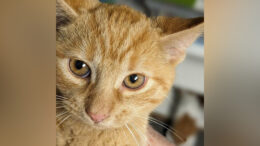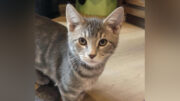BUCHAREST, Romania (AP) — A museum showcasing Romanian kitsch items, ranging from a life-size Dracula to communist-era glass fish, opened in the country’s capital on Friday.
The 215 exhibits also include a flat-screen television with flickering flames imitating an open fireplace, a cushion that looks like a one-euro coin, neon-lit Christian crosses, and a reclining naked man whose body is covered with 50 lei notes (each worth about $12).

In this Thursday, May 4, 2017, photo, Communist era milk bottles are on display along with a metal fish at the newly opened Bucharest Kitsch Museum, in Bucharest, Romania. (AP)
The first thing you see upon entering the museum is a copy of Michelangelo’s world-famous statue of David. But that’s the only reference to classical art in this space devoted to kitsch.
The statue, a miniature copy of the 16th-century century sculpture, wears a gaudy gilt necklace with a large U.S. dollar pendant and stands on a sequined cloth, setting the tone for visitors to the Romanian Kitsch Museum.
Some objects are Romanian retro such as glass fish that adorned TV sets in the communist era and brightly colored crocheted blankets. Others have a more universal appeal: The “Pitzipoanca” is a glam woman dressed in fishnets, a neon dress and a fake Versace baseball cap. Her male equivalent, the “Cocalar,” shows off in a fur waistcoat, sunglasses, diamante watch and track trousers.
As well as kitsch local music, there’s also fake news. The headline in a 2001 edition of the Dracula weekly is: “Extraterrestrials steal electric current.”
The museum’s first visitor, Sorin Balanescu, says that kitsch, which has become more prevalent since communism ended, is an eyesore in Bucharest.
“There is an invasion (of kitsch) that is so tiring and ugly,” he said. “You can’t see the city because of the billboards … I don’t know how we will get rid of it.”
Even the entrance fee is influenced by kitsch. Foreigners pay 30 lei ($7.23) to visit the museum located in the Old Town (Centru Vechi) tourist district, while Romanians pay 20 lei ($4.8). Owner Cristian Lica says Romanians get a reduction in “a show of solidarity because they are exposed daily to kitsch.”
Some exhibits may cause controversy and even offense.
A section on Roma, or Gypsies, regurgitates stereotypes. A pregnant Gypsy woman stands next to a model baby lying on the ground and a metal bucket full of sunflower seeds, the image of a poor Roma woman. In another corner, there are photos of ornate houses with turrets which are labeled “Gypsy Architecture,” a style of house favored by some well-off Roma.
Images of Orthodox clerics next to expensive cars prompt Lica to say: “Jesus Christ was spiritually rich, priests are materially rich.” A news item relating how priests were suspended for blessing sex shops and brothels is also part of the exhibit.
Asked about racial stereotyping, Lica says that he is aware there may be negative reactions, but adds “I don’t want to insult anyone’s feelings.”
He previously worked in advertising and has been collecting kitsch objects for 21 years and is fascinated by it, though he also deems it toxic and too prevalent.
“Kitsch is a form of expression. It’s failed art,” he said, sitting at a table with a bowl of plastic fruit on it. “Some of it is a cliche and repetitive like Mona Lisa copies. Some is creative kitsch.”
Dressed in a T-shirt decorated with a sequined skull and white loafers with silver buckles, Lica’s favorite item is a photo of Nicolae Ceausescu standing with a presidential scepter, and a telegram sent by artist Salvador Dali, showing the personality cult the Communist leader cultivated before he was overthrown and executed during the 1989 revolution.
Lica has visited 500 museums and was inspired by boutique museums dedicated to cocaine, cannabis, sex and torture.
The museum has different sections: contemporary kitsch, communist kitsch, Gypsy kitsch, Dracula kitsch and Orthodox Church kitsch.
Not everyone was taken by the idea of exhibiting kitsch. Communications consultant Catrinel Dumitru said Bucharest had other monuments and museums to offer tourists, saying Romanians were likely to be the first visitors.
“I wouldn’t recommend this as the first place for foreigners,” Dumitru said.



























